5 books about Shiloh
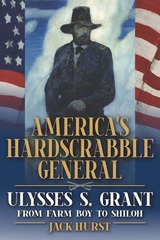
America’s Hardscrabble General
Ulysses S. Grant, from Farm Boy to Shiloh
Jack Hurst
Southern Illinois University Press, 2022
How Grant’s humble beginnings shaped his unique military genius
Renowned for his skill, courage, and indomitability during the Civil War, Ulysses S. Grant is considered a model for outstanding American generalship. However, unlike most of his fellow officers, Grant came from humble Midwestern beginnings and experienced a number of professional failures before rising to military prominence.
Grant grew up on a farm on the Ohio frontier and reluctantly attended West Point, where he finished in the middle of his class. In his early army career, he was often underestimated by his peers despite valiant service. After the Mexican War Grant’s “Hardscrabble” farm outside St. Louis failed, and when he decided to rejoin the U.S. army, he was given the unenviable command of a rowdy volunteer regiment, the 21st Illinois.
How did Grant—an average student, failed farmer, and common man—turn the 21st Illinois into a showcase regiment and become a successful general? In this engaging analysis, Jack Hurst argues that Grant’s military brilliance stemmed not from his West Point education but rather from his roots in America’s lower middle class and its commonsense values. His upbringing in the antebellum rural Midwest undergirded his military skill and helped him develop an innate humility, sense of justice, and ability to focus, leading him to form close relationships with his men.
Through a detailed account of Grant’s early years, from boyhood through the Battle of Shiloh, Hurst explores how Grant’s modest start and experiences in the Mexican War prefigured his greatest military triumphs. Ultimately Grant abandoned the traditional military practice of his time, which relied upon maneuver, and instead focused on fighting. His strategy to always move forward, win or lose, turned even his losses into essential elements of victory and characterized the aggressive, relentless approach that would ultimately win the Civil War and save the Union.
Renowned for his skill, courage, and indomitability during the Civil War, Ulysses S. Grant is considered a model for outstanding American generalship. However, unlike most of his fellow officers, Grant came from humble Midwestern beginnings and experienced a number of professional failures before rising to military prominence.
Grant grew up on a farm on the Ohio frontier and reluctantly attended West Point, where he finished in the middle of his class. In his early army career, he was often underestimated by his peers despite valiant service. After the Mexican War Grant’s “Hardscrabble” farm outside St. Louis failed, and when he decided to rejoin the U.S. army, he was given the unenviable command of a rowdy volunteer regiment, the 21st Illinois.
How did Grant—an average student, failed farmer, and common man—turn the 21st Illinois into a showcase regiment and become a successful general? In this engaging analysis, Jack Hurst argues that Grant’s military brilliance stemmed not from his West Point education but rather from his roots in America’s lower middle class and its commonsense values. His upbringing in the antebellum rural Midwest undergirded his military skill and helped him develop an innate humility, sense of justice, and ability to focus, leading him to form close relationships with his men.
Through a detailed account of Grant’s early years, from boyhood through the Battle of Shiloh, Hurst explores how Grant’s modest start and experiences in the Mexican War prefigured his greatest military triumphs. Ultimately Grant abandoned the traditional military practice of his time, which relied upon maneuver, and instead focused on fighting. His strategy to always move forward, win or lose, turned even his losses into essential elements of victory and characterized the aggressive, relentless approach that would ultimately win the Civil War and save the Union.
[more]
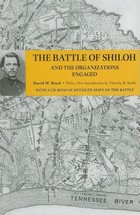
The Battle of Shiloh and the Organizations Engaged
D. W. Reed
University of Tennessee Press, 2008
Originally published in 1902 by the Government Printing Office (and revised and reprinted in 1909 and 1913), The Battle of Shiloh and the Organizations Engaged was the official park commission history of this important battle and remains a seminal work on the subject. Although the book is the cornerstone of Shiloh historiography and is extensively cited by serious historians, the original edition is not widely available today. Timothy B. Smith redresses this problem with this new reprint of the 1913 edition for which he has written an introduction that places the important work in historical context.
Written by D. W. Reed, a veteran of the battle and the first official historian of the Shiloh National Military Park, The Battle of Shiloh and the Organizations Engaged provides a succinct and authoritative overview of the battle. In addition to a narrative of the campaign, Reed describes the units engaged and the movements of every brigade. In addition, he includes numerous tables of strengths and losses for the armies as well as remarkably detailed maps and diagrams showing the action as it unfolded. These spectacular color maps are accessible in an enclosed CD in a PDF format. The net result is a compact yet detailed view of Shiloh unmatched anywhere else.
Even a century after its first publication, this book stands as one of the most dependable, concise, and important works on the Battle of Shiloh. This new edition makes this work accessible once again.
D. W. Reed was a veteran of the Battle of Shiloh and the first historian of the Shiloh National Military Park.
Timothy B. Smith is the author of This Great Battlefield of Shiloh: History, Memory, and the Establishment of a Civil War National Military Park and The Untold Story of Shiloh: The Battle and the Battlefield. He was a park ranger at the Shiloh National Military Park before accepting a teaching position at the University of Tennessee at Martin.
Written by D. W. Reed, a veteran of the battle and the first official historian of the Shiloh National Military Park, The Battle of Shiloh and the Organizations Engaged provides a succinct and authoritative overview of the battle. In addition to a narrative of the campaign, Reed describes the units engaged and the movements of every brigade. In addition, he includes numerous tables of strengths and losses for the armies as well as remarkably detailed maps and diagrams showing the action as it unfolded. These spectacular color maps are accessible in an enclosed CD in a PDF format. The net result is a compact yet detailed view of Shiloh unmatched anywhere else.
Even a century after its first publication, this book stands as one of the most dependable, concise, and important works on the Battle of Shiloh. This new edition makes this work accessible once again.
D. W. Reed was a veteran of the Battle of Shiloh and the first historian of the Shiloh National Military Park.
Timothy B. Smith is the author of This Great Battlefield of Shiloh: History, Memory, and the Establishment of a Civil War National Military Park and The Untold Story of Shiloh: The Battle and the Battlefield. He was a park ranger at the Shiloh National Military Park before accepting a teaching position at the University of Tennessee at Martin.
[more]
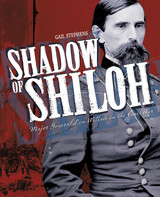
Shadow of Shiloh
Major General Lew Wallace in the Civil War
Gail Stephens
Indiana Historical Society Press, 2010
Thirty-two years after the battle of Shiloh, Lew Wallace returned to the battlefield, mapping the route of his April 1862 march. Ulysses S. Grant, Wallace's commander at Shiloh, expected Wallace and his Third Division to arrive early in the afternoon of April 6. Wallace and his men, however, did not arrive until nightfall, and in the aftermath of the bloodbath of Shiloh Grant attributed Wallace's late arrival to a failure to obey orders. By mapping the route of his march and proving how and where he had actually been that day, the sixty-seven-year-old Wallace hoped to remove the stigma of "Shiloh and its slanders." That did not happen. Shiloh still defines Wallace's military reputation, overshadowing the rest of his stellar military career and making it easy to forget that in April 1862 he was a rising military star, the youngest major general in the Union army.
Wallace was devoted to the Union, but he was also pursuing glory, fame, and honor when he volunteered to serve in April 1861. In Shadow of Shiloh: Major General Lew Wallace in the Civil War, author Gail Stephens specifically addresses Wallace's military career and its place in the larger context of Civil War military history.
[more]
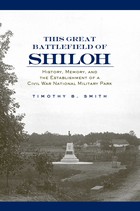
This Great Battlefield of Shiloh
History, Memory, and the Establishment of a Civil War National Military Park
Timothy B. Smith
University of Tennessee Press, 2004
Around the turn of the last century, feelings of patriotism, nationalism, and sectional reconciliation swept the United States and led to a nationwide memorialization of American military history in general and the Civil War in particular. The 1894 establishment of the Shiloh National Military Park, for example, grew out of an effort by veterans themselves to preserve and protect the site of one of the Civil War’s most important engagements.
Returning to the Pittsburg Landing battlefield, Shiloh veterans organized themselves to push the Federal government into establishing a park to honor both the living participants in the battle and those who died there. In a larger sense, these veterans also contributed to the contemporaneous reconciliation of the North and the South by focusing on the honor, courage, and bravery of Civil War soldiers instead of continuing divisive debates on slavery and race.
This Great Battlefield of Shiloh tells the story of their efforts from the end of the battle to the park’s incorporation within the National Park Service in 1933. The War Department appointed a park commission made up of veterans of the battle. This commission surveyed and mapped the field, purchased land, opened roads, marked troop positions, and established the historical interpretation of the early April 1862 battle. Many aged veterans literally gave the remainder of their lives in the effort to plan, build, and maintain Shiloh National Military Park for all veterans. By studying the establishment and administration of parks such as the one at Shiloh, the modern scholar can learn much about the mindsets of both veterans and their civilian contemporaries regarding the Civil War. This book represents an important addition to the growing body of work on the history of national remembrance.
Returning to the Pittsburg Landing battlefield, Shiloh veterans organized themselves to push the Federal government into establishing a park to honor both the living participants in the battle and those who died there. In a larger sense, these veterans also contributed to the contemporaneous reconciliation of the North and the South by focusing on the honor, courage, and bravery of Civil War soldiers instead of continuing divisive debates on slavery and race.
This Great Battlefield of Shiloh tells the story of their efforts from the end of the battle to the park’s incorporation within the National Park Service in 1933. The War Department appointed a park commission made up of veterans of the battle. This commission surveyed and mapped the field, purchased land, opened roads, marked troop positions, and established the historical interpretation of the early April 1862 battle. Many aged veterans literally gave the remainder of their lives in the effort to plan, build, and maintain Shiloh National Military Park for all veterans. By studying the establishment and administration of parks such as the one at Shiloh, the modern scholar can learn much about the mindsets of both veterans and their civilian contemporaries regarding the Civil War. This book represents an important addition to the growing body of work on the history of national remembrance.
[more]
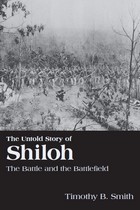
The Untold Story of Shiloh
The Battle and the Battlefield
Timothy B. Smith
University of Tennessee Press, 2007
At the mention of Shiloh, most tend to think of two particularly bloody and crucial days in April 1862. The complete story, however, encompasses much more history than that of the battle itself. While several accounts have taken a comprehensive approach to Shiloh, significant gaps still remain in the collective understanding of the battle and battlefield.
In The Untold Story of Shiloh, Timothy B. Smith fills in those gaps, looking beyond two days of battle and offering unique insight into the history of unexplored periods and topics concerning the Battle of Shiloh and the Shiloh National Military Park.
This collection of essays, some previously unpublished, tackles a diverse range of subjects, including Shiloh's historiography, the myths about the battle that were created, and the mindsets that were established after the battle. The book reveals neglected military aspects of the battle, such as the naval contribution, the climax of the Shiloh campaign at Corinth, and the soldiers' views of the battle. The essays also focus on the Shiloh National Military Park's establishment and continuation with particular emphasis on those who played key roles in its creation.
Taken together, the essays tell the overall story of Shiloh in greater detail than ever before. General readers and historians alike will discover that The Untold Story of Shiloh is an important contribution to their understanding of this crucial episode in the Civil War.
Timothy B. Smith is on staff at the Shiloh National Military Park. He is author of Champion Hill: Decisive Battle for Vicksburg and This Great Battlefield of Shiloh: History, Memory, and the Establishment of a Civil War National Military Park.
In The Untold Story of Shiloh, Timothy B. Smith fills in those gaps, looking beyond two days of battle and offering unique insight into the history of unexplored periods and topics concerning the Battle of Shiloh and the Shiloh National Military Park.
This collection of essays, some previously unpublished, tackles a diverse range of subjects, including Shiloh's historiography, the myths about the battle that were created, and the mindsets that were established after the battle. The book reveals neglected military aspects of the battle, such as the naval contribution, the climax of the Shiloh campaign at Corinth, and the soldiers' views of the battle. The essays also focus on the Shiloh National Military Park's establishment and continuation with particular emphasis on those who played key roles in its creation.
Taken together, the essays tell the overall story of Shiloh in greater detail than ever before. General readers and historians alike will discover that The Untold Story of Shiloh is an important contribution to their understanding of this crucial episode in the Civil War.
Timothy B. Smith is on staff at the Shiloh National Military Park. He is author of Champion Hill: Decisive Battle for Vicksburg and This Great Battlefield of Shiloh: History, Memory, and the Establishment of a Civil War National Military Park.
[more]
READERS
Browse our collection.
PUBLISHERS
See BiblioVault's publisher services.
STUDENT SERVICES
Files for college accessibility offices.
UChicago Accessibility Resources
home | accessibility | search | about | contact us
BiblioVault ® 2001 - 2024
The University of Chicago Press









